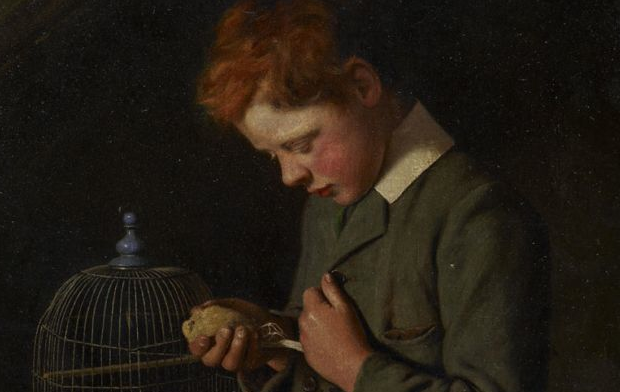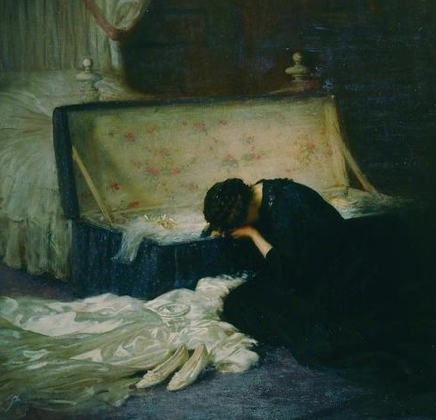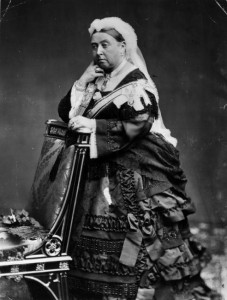December, 1861: Prince Albert feels pangs of what wife Queen Victoria describes as “a nasty, feverish sort of influenza and a deranged stomach.” He retires from the household Christmas festivities, bed-ridden, and passes away on the dawn of December 14th, surrounded by friends, family, and an impossibly grief-stricken Victoria. Albert was relatively young. He was 42 when he died with his wife at his side, urging him to ‘hang on’ and give her ‘a last kiss.’ One of Victoria’s dressers, Annie Macdonald, wrote that when she realized her husband had died, she could only “gaze wildly and as hard as a stone.” The wave of national mourning that commenced after Albert’s death would define an era; Victoria’s obsession with mourning and the ceremony surrounding it would influence the social norms, fashion, and art of the British people.
Death and mourning in the Victorian era became a gradual, visual experience. Widows wore black for years (Victoria even dressed her whole court in the color) and were encouraged to wear necklaces of lignite, a black gem made of fossilized coal. The mirrors of the household were to be covered. Thick cuffs known as “weepers” were added to a woman’s mourning garments so she could better wipe a crying eye. Mourning, it would seem, became not just a process – it became a social spectacle. And within the need for that spectacle, art became the perfect means of expressing grief.
Consider English painter Frederick Elwell’s work, The Wedding Dress (1911). In it, a woman sits on the floor of a black room. She is in a plain, black dress. Her face is buried in her hands, unable to make eye contact with the viewer. The trunk she leans on spills out a pearly wedding dress, while a pair of white heels stands beside it – the only composed thing in the room. It’s as if the shoes become the eyes of the woman and the voice of her grief, saying, this is the role you are stepping out of.
“It’s as if the shoes become the eyes of the woman and the voice of her grief, saying, this is the role you are stepping out of.”

“His First Grief” (1910) by Charles Spencelayh.
(Credit: mylearning.org)
It’s the composition of The Wedding Dress that makes Elwell’s work such a strong example of death and mourning’s prominence in the Victorian era. As the female figure shares the painting’s center with the dress, we come to regard the garment as an extension of her identity that – along with her husband – she has lost.
“As the female figure shares the painting’s center with the dress, we come to regard the garment as an extension of her identity that — along with her husband — she has lost.”
The mourning is so commanding and unabashed in Victorian works like The Wedding Dress that it’s easy to become critical of the era as one that indulged too deeply in death and loss. Does grief need to become so ostentatious? After WWII, the topic of dying became such a hushed topic that it’s taken decades to begin opening up the conversation on end of life again. One can criticize Victorians for being over the top – but they were never hesitant to explore the topic of death. They represent an important, brazen part of our history that we should keep in mind as we re-open the conversation on death and dying.
You may like:
- The Hour of Lead: Emily Dickinson perfectly captures the numbness we experience after the passing of a loved one
- The Empty Mirror and the Rainbow-Bird: Elizabeth Bishop‘s images in “Sonnet” makes the end of life a release into joy
- A Man Immortal: Roman Funeral Sculptures

 The Victorian Era & the Art of Mourning
The Victorian Era & the Art of Mourning





 Our Annual Seven Holiday Gifts for Someone Who Is Grieving, 2024 Edition
Our Annual Seven Holiday Gifts for Someone Who Is Grieving, 2024 Edition
 “Making Mobiles” by Karolina Merska
“Making Mobiles” by Karolina Merska
 “Hands Up to the Sky” by Michael Franti & Spearhead
“Hands Up to the Sky” by Michael Franti & Spearhead















I have wondered why we do not still allow people to morn by wearing black today. The opportunity to grieve alone and let others know you need space is missing from society.
Report this comment